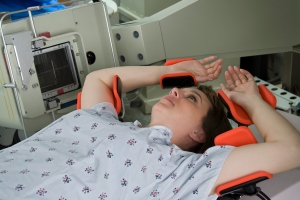Take-Home Pearl: Accelerated partial breast irradiation with external beam radiation therapy increases the 3-year rates of adverse cosmetic outcome, as compared to more traditional whole breast external beam radiation therapy.
Accelerated partial breast irradiation (APBI) was developed to improve convenience and access to breast irradiation. Because most recurrences after breast-conserving surgery occur at the primary site, radiation therapy to this area may result in outcomes similar to those with whole breast irradiation for carefully selected patients. But, are the cosmetic outcomes different when comparing accelerated, partial breast radiation therapy (twice daily for 5 to 8 days) or more traditional whole breast radiation therapy (42.5 Gy in 16 treatments or 50 Gy in 25 daily treatments)? A multi center, prospective randomized trial recently helped answer that question.
The Study: All patients (2,135) had either invasive ductal cancer or ductal carcinoma in situ, and underwent breast-conserving surgery. The margins had to be clear, and the nodes uninvolved. Exclusion criteria included age under 40, tumor size over 3 cm, lobular cancer, and multicentric disease.
Patients were randomly assigned to either accelerated partial breast irradiation (APBI) using so-called 3-D conformal external beam radiation therapy or whole breast radiation therapy. The APBI dose was 38.5 Gy in 10 fractions, twice daily. The whole breast RT was as above.
Results: Accelerated partial breast irradiation (APBI) had a higher rate of bad cosmetic outcomes and late toxicity, as compared with standard whole breast radiation therapy 29% versus 16.5% at the 3-year mark). While significant toxicity was unusual for both approaches, mild to moderate toxicities were moe common with the partial breast radiation therapy approach.
My Take: This study did not evaluate other forms of partial breast irradiation, such as with a radiation-containing balloon or the single treatment, in the operating room approach. We have completed a study comparing these other approaches to whole breast radiation therapy (NSABP B-39/RTOG 0413), with long-term results pending. I’m Dr. Michael Hunter.
The small print: The material presented herein is informational only, and is not designed to provide specific guidance for an individual. Please check with a valued health care provider with any questions or concerns. As for me, I am a Harvard- , Yale- and UPenn-educated radiation oncologist, and I practice in the Seattle, WA (USA) area. I feel genuinely privileged to be able to share with you. If you enjoyed today’s offering, please consider clicking the follow button at the bottom of this page.
Available now: Understand Colon Cancer in 60 Minutes; Understand Brain Glioma in 60 Minutes. Both can be found at the Apple Ibooks store. Coming Soon for iPad: Understand Breast Cancer in 60 Minutes; Understand Colon Cancer in 60 Minute; Understand Colon Cancer in 60 Minutes; Understand Brain Glioma in 60 Minutes. Thank you.
Reference: Olivotto IA [British Columbia Cancer Agency, Victoria, CANADA), et al. J Clinical Oncology 2013;31 (November 10): 4038-4045.
